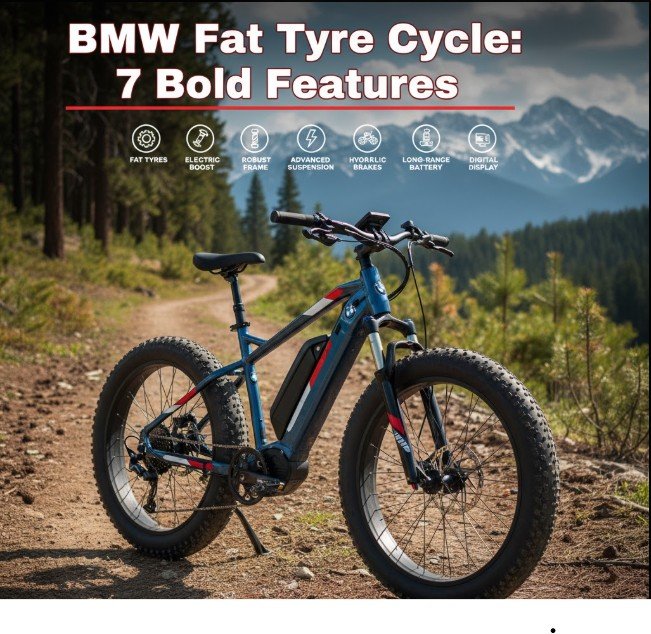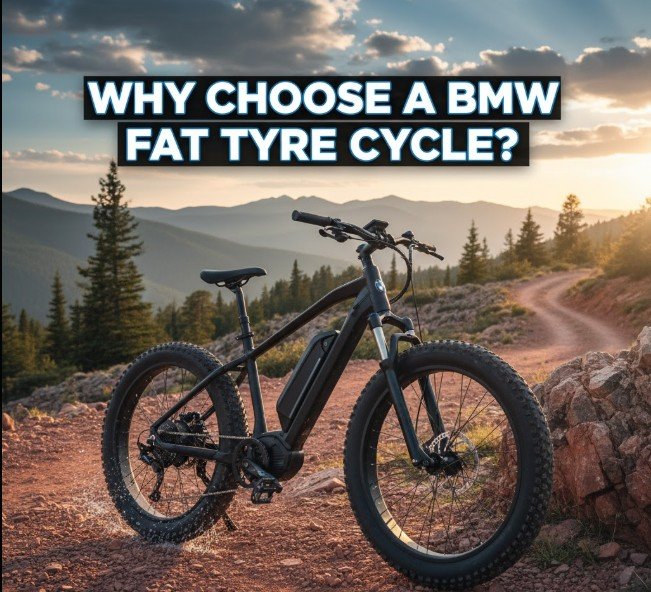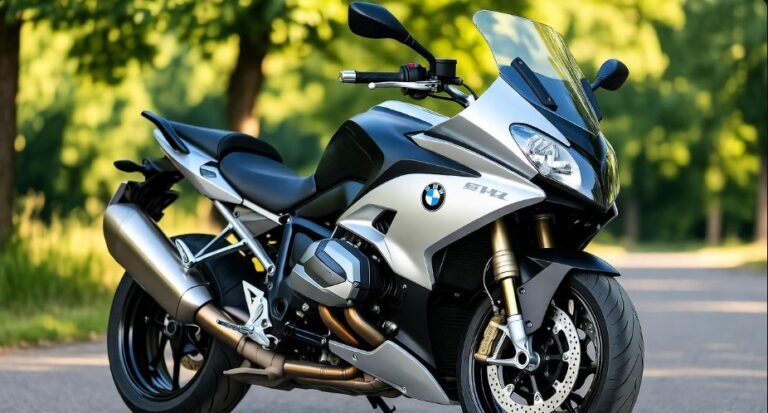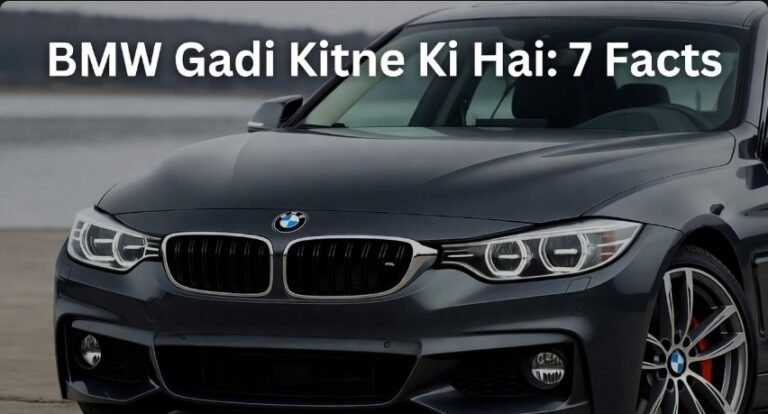BMW Fat Tyre Cycle: 7 Bold Features

Discover the BMW Fat Tyre Cycle: 7 Bold Features Designed for Adventure and Style.
Key Takeaways
Explore BMW’s innovative fat tyre cycles for ultimate off-road and urban riding.
Understand the benefits of fat tyres for stability and traction.
Learn about the robust build and premium components of these cycles.
See how BMW integrates technology for a superior cycling experience.
Discover the sleek design and bold aesthetics that define these models.
When you think of BMW, images of precision engineering and luxurious automotive performance likely come to mind. But did you know BMW also applies this renowned expertise to the world of cycling? Specifically, their fat tyre cycles are turning heads, combining rugged capability with sophisticated design. These impressive machines are built for riders who want to tackle diverse terrains with confidence and style. If you’re curious about what makes a BMW fat tyre cycle stand out, you’ve come to the right place. We’ll break down the seven bold features that make these bikes a truly unique offering. Get ready to discover a new level of cycling adventure.
Why Choose a BMW Fat Tyre Cycle?

The automotive industry in the USA is a beacon of innovation, and this spirit extends to personal mobility solutions beyond cars. BMW’s foray into the cycling world, particularly with their fat tyre models, reflects a commitment to versatile and high-quality recreational products. Fat tyre cycles, also known as “fat bikes,” have gained popularity for their ability to traverse surfaces that would challenge conventional bicycles. Think sandy beaches, snowy trails, or even rough, unpaved paths. These bikes offer a stable ride and enhanced grip, making them ideal for exploration and a fun, unique cycling experience. Choosing a BMW fat tyre cycle means opting for engineering excellence, premium materials, and a design that’s as stylish as it is functional.
7 Bold Features of the BMW Fat Tyre Cycle
BMW doesn’t just slap their badge on any product; they imbue their cycles with the same dedication to quality and performance found in their vehicles. Here are the seven bold features that make a BMW fat tyre cycle a standout choice for enthusiasts and casual riders alike.
1. Unrivaled Fat Tyre Performance
The hallmark of any fat tyre cycle is its tires, and BMW doesn’t compromise here. These cycles typically come equipped with extra-wide tyres, often measuring 4 inches or more in width. This generous footprint provides several key advantages:
Superior Traction: The larger surface area grips the ground exceptionally well, offering enhanced stability and control on loose surfaces like sand, mud, and snow.
Unmatched Comfort: The increased volume of air within these large tires allows them to act as a natural suspension system. This absorbs bumps and vibrations, delivering an incredibly smooth ride, even on rough terrain.
All-Terrain Capability: Whether you’re cruising along a beach boardwalk or exploring a forest trail, these tires offer the confidence to tackle almost any surface.
This feature alone transforms the cycling experience, opening up new possibilities for where and how you can ride.
2. Robust Frame Construction
A fat tyre cycle needs a frame that can withstand the demands of varied terrain and the stresses associated with wider tires. BMW cycles are built with high-quality materials for durability and performance.
Lightweight Aluminum Alloys: Many BMW fat tyre cycles utilize advanced aluminum alloys for their frames. This provides an excellent balance of strength, stiffness, and light weight, making the bike easier to maneuver and transport.
Ergonomic Design: The frame geometry is designed for comfort and efficient pedaling, ensuring a pleasant riding experience for extended periods.
Durable Finishes: Expect premium paint and finishing that not only looks great but also protects the frame from the elements, a trademark of BMW’s attention to detail.
This sturdy foundation ensures your BMW fat tyre cycle is ready for adventure, year after year.
3. Advanced Drivetrain and Gearing
To complement the robust build, BMW fat tyre cycles are outfitted with reliable and high-performance drivetrain components.
Shimano or SRAM Components: Often featuring high-quality components from industry leaders like Shimano or SRAM, these cycles offer smooth and precise gear shifting.
Wide Gear Range: A broad range of gears allows riders to tackle steep climbs with ease and maintain speed on flat terrain, making them versatile for various riding conditions.
Durable Chains and Cassettes: Built to last, the drivetrain components are chosen for their ability to withstand the rigors of off-road use and varying weather conditions.
The ability to easily adjust your gearing means you can focus more on enjoying the ride and less on struggling with the terrain.
4. Powerful Braking Systems
Safety and control are paramount, especially when riding fat tyre cycles on varied surfaces. BMW integrates effective braking systems to ensure riders can stop confidently.
Hydraulic Disc Brakes: Many models feature hydraulic disc brakes, which offer superior stopping power and modulation compared to mechanical brakes. They perform consistently in all weather conditions, from dry to wet and muddy trails.
Large Rotor Sizes: The use of larger brake rotors further enhances braking performance, providing more leverage and heat dissipation, crucial for sustained descents.
With reliable brakes, you can descend hills and navigate tricky sections with peace of mind.
5. Ergonomic Cockpit and Comfort Features
BMW understands that a comfortable rider is a happy rider. The cockpit and contact points on their fat tyre cycles are designed with user experience in mind.
Comfortable Saddle: A well-designed saddle distributes weight evenly, reducing pressure points and allowing for longer rides without discomfort.
Ergonomic Grips: Handlebar grips are shaped to fit the natural curvature of your hands, reducing fatigue and improving control.
Adjustable Handlebars and Seat Post: The ability to easily adjust handlebar height and saddle position ensures riders of different proportions can find their ideal fit, maximizing comfort and efficiency.
These thoughtful details make a significant difference over the course of a ride.
6. Integrated Lighting Systems
Safety is a priority, and the inclusion of integrated lighting systems on some BMW fat tyre cycle models enhances visibility and allows for riding in low-light conditions.
Front and Rear Lights: Often equipped with front and rear LED lights, these cycles ensure you are seen by others and can see your path ahead.
Dynamo or Battery Powered: Depending on the model, lighting systems may be powered by a dynamo hub, generating power as you ride, or by efficient batteries, providing reliable illumination.
This feature is particularly valuable for urban commuters or those who enjoy early morning or late evening rides.
7. Iconic BMW Design and Aesthetics
Beyond performance and functionality, BMW fat tyre cycles boast a distinct aesthetic that reflects the brand’s commitment to style and sophistication.
Sleek Lines and Finish: Expect clean lines, a refined color palette, and subtle branding that speaks to BMW’s automotive design language.
Premium Accents: Details like branded components, refined welds, and thoughtful finishing touches elevate the visual appeal.
Modern Look: These cycles are designed to look as good as they ride, making them a statement piece whether you’re on a trail or in the city.
The blend of rugged capability and premium design ensures that a BMW fat tyre cycle is not just a mode of transportation, but a lifestyle accessory.
A Quick Comparison: BMW Fat Tyre Cycle vs. Traditional Mountain Bike
To further illustrate the unique advantages of a BMW fat tyre cycle, consider how it stacks up against a traditional mountain bike. While both are designed for off-road adventures, the fat tyre cycle offers distinct benefits for specific riding conditions.
| Feature | BMW Fat Tyre Cycle | Traditional Mountain Bike |
|---|---|---|
| Tyre Width | 4 inches or wider | Typically 2.0 – 2.6 inches |
| Traction | Exceptional on soft surfaces (sand, snow, mud) | Good on varied trails, but can struggle on very loose surfaces |
| Comfort | High due to large air volume acting as suspension | Relies heavily on front suspension for comfort |
| Terrain Specialization | Sand, snow, mud, loose gravel, rough trails | General trail riding, singletrack, downhill |
| Weight | Can be heavier due to larger tires and rims | Generally lighter, especially with carbon components |
| Rolling Resistance | Higher on hard surfaces, lower on soft surfaces | Lower on hard surfaces |
| Maintenance | Tires require specific pressure, but generally robust | Suspension systems require regular maintenance |
As you can see, the fat tyre cycle excels where conventional bikes might falter, particularly on surfaces where flotation and grip are paramount.
Pro Tip: When riding a fat tyre cycle, experiment with tire pressure to find the optimal balance between comfort, traction, and rolling resistance for different terrains. Lower pressure generally means more grip and comfort on soft surfaces, while slightly higher pressure can be more efficient on harder-packed trails.
The BMW Fat Tyre Cycle in Action: Real-World Scenarios
Imagine yourself on a crisp autumn morning, the leaves crunching underfoot. You’re on a BMW fat tyre cycle, gliding effortlessly along a forest path that would be a muddy mess for a regular bike. The wide tires simply float over the damp earth, providing stable, confident handling.
Or perhaps you’re visiting a coastal town in the USA, the ocean breeze in your hair. Instead of a conventional bike struggling in the soft sand, your BMW fat tyre cycle rolls smoothly along the beach. The large tires distribute your weight, allowing you to explore the shoreline like never before.
For those living in regions with snowy winters, the fat tyre cycle becomes a year-round adventure machine. Glide over fresh powder or packed snow, enjoying the winter landscape without being confined indoors. This versatility is at the heart of the BMW fat tyre cycle’s appeal.
Maintenance and Care for Your BMW Fat Tyre Cycle
Just like any high-performance vehicle, your BMW fat tyre cycle requires proper care to ensure it operates at its best. While they are built for durability, a little attention goes a long way.
Regular Cleaning
After riding in mud, sand, or rain, it’s essential to clean your bike. Use a hose (avoiding high-pressure sprays directly at bearings) and a mild soap.
Dry the bike thoroughly with a clean cloth.
Tire Pressure Checks
As mentioned, tire pressure is crucial for fat tyre cycles. Check it before every ride.
Refer to the tire sidewall or BMW’s recommendations for optimal pressure ranges, which vary based on terrain and rider weight. A good starting point for loose surfaces is often between 5-15 PSI.
Drivetrain Lubrication
Keep your chain clean and lubricated. Use a quality bicycle chain lubricant.
Wipe off excess lube to prevent dirt buildup.
Brake Checks
Regularly inspect your brake pads for wear.
Ensure hydraulic brake levers feel firm; if they feel spongy, they may need bleeding, a service best left to professionals.
General Inspection
Periodically check all bolts and components for tightness.
Inspect tires for any cuts or damage.
For more in-depth maintenance guides and local services in the USA, you can consult resources like the Bicycle Habitat Maintenance Guide, which offers excellent foundational advice applicable to all bikes.
Frequently Asked Questions About BMW Fat Tyre Cycles
What makes a fat tyre cycle different from a regular bicycle?
The primary difference is the tire width. Fat tyres are significantly wider (typically 3.8 inches or more) than those on standard bicycles, providing greater flotation, traction, and a softer ride on challenging surfaces.
Are BMW fat tyre cycles good for commuting?
Yes, they can be excellent for commuting, especially if your route involves varied terrain, unpaved paths, or you ride in areas with snow. The comfort and stability are significant benefits. However, on smooth asphalt, they can have more rolling resistance than a road bike.
Do I need special tools to maintain a BMW fat tyre cycle?
Basic maintenance like cleaning and tire inflation requires standard bicycle tools. However, for more complex tasks like drivetrain adjustments or brake servicing, specialized bike tools and knowledge are beneficial.
Where can I buy a BMW fat tyre cycle in the USA?
BMW typically partners with authorized dealerships or specialized cycling retailers for their bicycle offerings. It’s best to check BMW’s official website or contact a BMW dealer in your area for purchasing information and availability.
How do I choose the right tire pressure for my BMW fat tyre cycle?
Tire pressure is highly dependent on the rider’s weight, the tire size, and the terrain. A good starting point for riding on sand or snow is around 5-8 PSI, while for harder-packed trails, you might increase it to 10-15 PSI. Experimentation is key to finding your sweet spot.
Can fat tyre cycles be ridden on paved roads?
Absolutely. While they are engineered for off-road, they perform perfectly fine on paved roads. They might feel a bit slower due to the tire’s rolling resistance, but the comfort can make urban riding very enjoyable.
What kind of maintenance do the fat tyres themselves require?
The main maintenance for fat tyres involves checking and adjusting tire pressure regularly. Inspect them for wear and tear, and ensure they are free of debris after rides. They are generally very durable.
Conclusion
The BMW fat tyre cycle represents a fusion of cutting-edge automotive design principles with the adventurous spirit of cycling. Its seven bold features – from the unparalleled performance of its fat tires and robust frame construction to its advanced drivetrains, powerful brakes, ergonomic design, integrated lighting, and signature BMW aesthetics – create a riding experience that is both thrilling and supremely comfortable. Whether you’re navigating challenging off-road trails, cruising sandy beaches, or simply seeking a stylish and capable ride for your daily commute in the USA, a BMW fat tyre cycle offers a unique blend of capability, innovation, and luxury. It’s more than just a bicycle; it’s an invitation to explore further and ride bolder.



